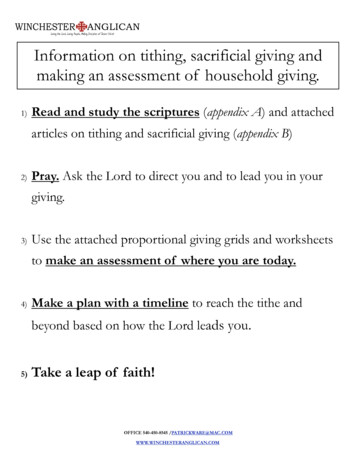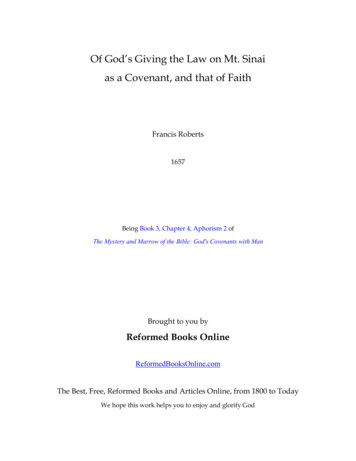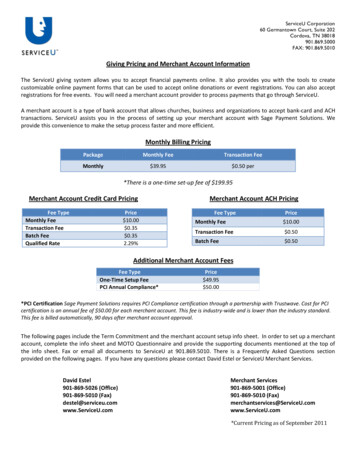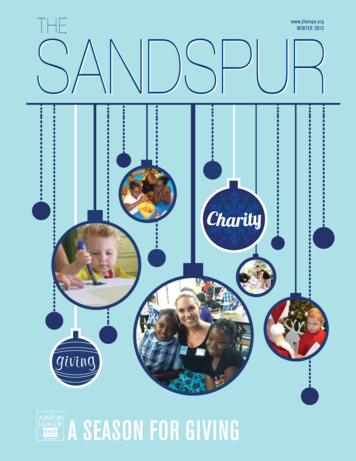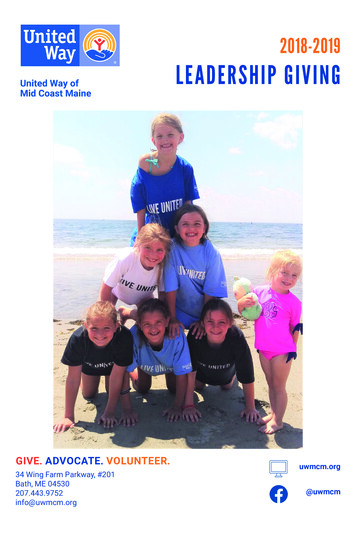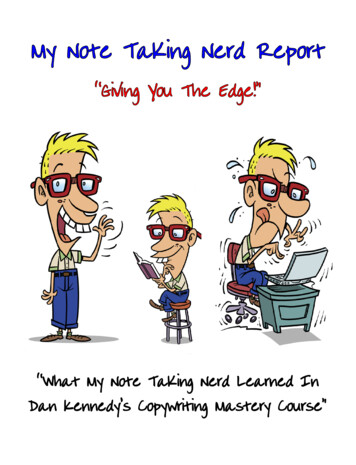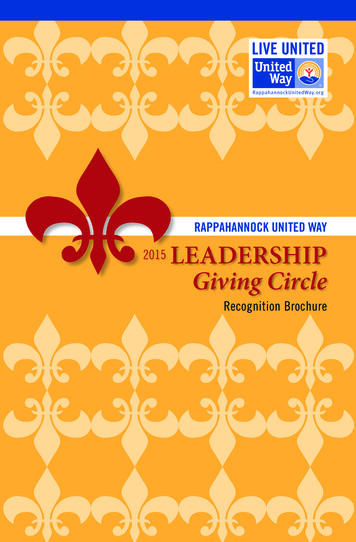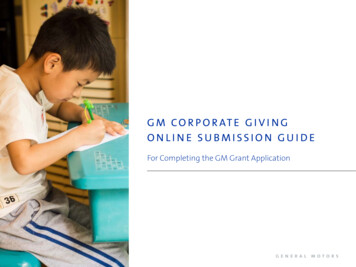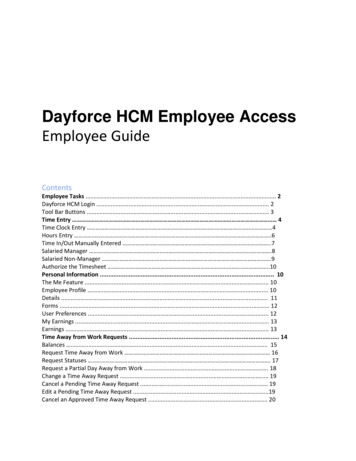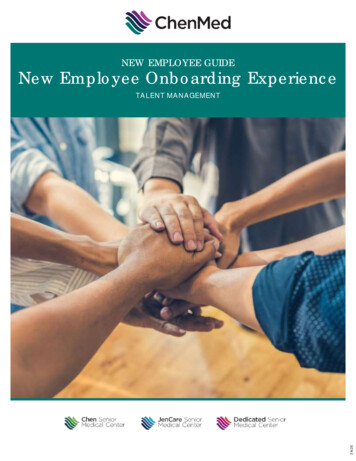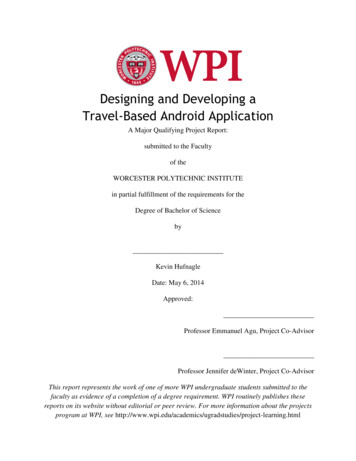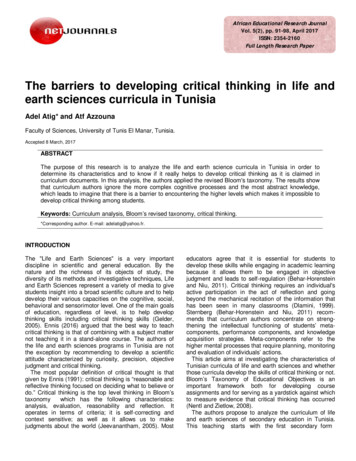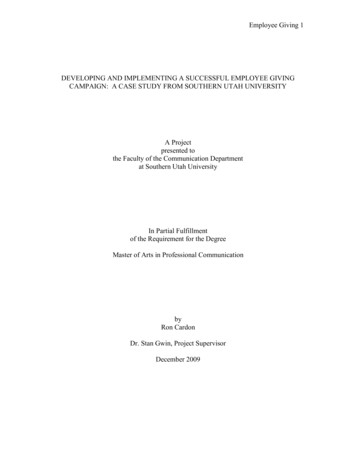
Transcription
Employee Giving 1DEVELOPING AND IMPLEMENTING A SUCCESSFUL EMPLOYEE GIVINGCAMPAIGN: A CASE STUDY FROM SOUTHERN UTAH UNIVERSITYA Projectpresented tothe Faculty of the Communication Departmentat Southern Utah UniversityIn Partial Fulfillmentof the Requirement for the DegreeMaster of Arts in Professional CommunicationbyRon CardonDr. Stan Gwin, Project SupervisorDecember 2009
Employee Giving 2
Employee Giving 3DEVELOPING AND IMPLEMENTING A SUCCESSFUL EMPLOYEE GIVINGCAMPAING: A CASE STUDY FROM SOUTHERN UTAH UNIVERISTYRon CardonDr. Stan Gwin, Project SupervisorABSTRACTThe 2008 Employee Giving Campaign at Southern Utah University (SUU) soughtto increase the number of employees giving financially to the university as a means ofleveraging larger donations from philanthropists, foundations, corporations and alumni.Three faculty and three staff members served as campaign chairs and as members of thesteering committee for the campaign. Campus departments were divided into teams and72 individuals served as captains of each team. Those individuals were trained and thencontacted each member of his or her team and asked for their participation in theemployee giving campaign. By the end of the campaign, the employee givingparticipation rate increased from 27% to 85% among benefits-eligible employees. Newemployee giving materials were designed, a new university artifact was introduced and ashift in the giving culture at SUU occurred as a result of the campaign.ii
Employee Giving 4ACKNOWLEDGEMENTSThis project and its success would not have been possible without severalindividuals: Stuart Jones for making the employee giving campaign an important part ofthe larger campaign at SUU and allowing me flexibility in its design and implementation;Mindy Benson for her ideas, direction and advice; Lynne Brown, Matt Barton, JimHarrison, Eric Houle, Clarisse Lunt and Linda Marriott for their dedicated leadership,support and service as campaign chairs; the 72 SUU employees who served as teamcaptains and willingly approached their colleagues and asked them to support thecampaign; and of course, the hundreds of SUU employees who gave of themselves forthe betterment of Southern Utah University.iii
Employee Giving 5TABLE OF CONTENTSABSTRACT. iiACKNOWLEDGEMENTS . iiiPLANNING . 7RESEARCH. 9INITITAL CONCEPTUALIZATION OF THE CAMPAIGN . 12TIMELINE FOR IMPLMENTATION . 17IDENTIFICATION OF COMMITTEE MEMBERS . 18INVITATION TO COMMITTEE MEMBERS TO SERVE . 18MEETING WITH COMMITTEE MEMBERS . 19DISCUSSION OF CAMPAIGN MATERISALS . 19TEAM CAPTAINS. 22CAMPAIGN KICK-OFF. 23FOLLOW THROUGH . 24HURDLES ALONG THE WAY. 25SUCCESSES. 27CHALLENGES . 28WHAT I LEARNED . 30WHAT I WOULD HAVE DONE DIFFERENTLY . 33CONCLUSION . 36
Employee Giving 6REFERENCES . 38APPENDICESA. Are You 100% SUU Poster . 39B. Drink Coupon . 41C. Employee Giving Payroll Deduction Card . 43D. 6 ½ x 9 ½ Envelope . 45E. 4 ¼ x 9 ½ Envelope. 47F. Steering Committee Meeting Agendas . 49G. Case for Support Statement . 55H. SUU Employee Giving Letter – First Draft . 57I. Eastern Michigan Employee Giving Letter Sample . 59J. U. of Connecticut Employee Giving Letter Sample . 41K. Western Maryland Employee Giving Letter Sample . 63L. Carnegie Mellon Employee Giving Letter Sample. 65M. SUU Employee Giving Letter – Final Draft . 67N. Common Questions and Answers for Team Captains . 69O. Team Captain Talking Points . 72P. Talking Points for VP of Advancement . 73VITA . 75iv
Employee Giving 7This project examines the 2008 internal campaign at Southern Utah University(SUU) that targeted full-time employees with the goal of increasing employee donationsto the university through payroll deductions. It explores the planning, research,conceptualization, timeline, volunteers, materials and kick-off of an employee givingcampaign. In addition, the hurdles, successes and challenges of the campaign arediscussed, as well as recommendations for future campaigns.The project was supervised by the Vice President for Institutional Advancementat SUU with faculty and staff members being invited to serve on a steering committee bythe president of the institution. Steering committee members helped carry out thecampaign and recruited colleagues to facilitate the employee-to-employee, face-to-faceasks. The goal was 60 to 70% participation among full-time employees. Final endparticipation rate was 85 percent.PLANNINGMichael T. Benson was hired as Southern Utah University‟s 15th president inNovember 2006. He announced during the selection process that if hired, he wouldlaunch an ambitious fundraising campaign of 115 million by 2012 – the largest amountever raised in a single campaign at SUU.To assist in guiding and directing this campaign, President Benson lured SUUalumnus Stuart Jones back to campus to once again serve as Vice President forInstitutional Advancement. Since alumni relations and development both comprise thedepartment of institutional advancement, his hiring had a direct impact on me and my jobresponsibilities. My official title was, and still is, associate director of alumni relations.
Employee Giving 8However, my actual job activities at the time included not just alumni duties, but alsothose of directing the annual giving program.The arrival of Vice President Jones to campus ushered in a new and increasedfocus on fundraising. For me that meant a more complete emphasis on the annual givingprogram and all that it entails. In the fall of 2007, he presented the idea of reinstitutingSUU‟s employee giving program. It had unofficially existed for years, but no one wascoordinating it at the time and a campus-wide push had not occurred since the mid 1990s.Jones explained that if President Benson‟s 115 million campaign was to succeed thepresident needed broad campus support and that a strong employee giving program couldaccomplish that and raise additional money. The employee giving campaign became myresponsibility and consequently my capstone project for a master‟s degree in professionalcommunication.Our employee giving campaign was seen by Institutional Advancement as animportant piece in laying the foundation for the comprehensive campaign entitled “TheFuture is Rising.” Vice President Jones felt strongly that this employee giving campaignhad to surpass the most successful SUU campaign ever. The campaign in the 1990‟sachieved 80% participation. It was argued that if the university‟s largest comprehensivecapital campaign was to be successful, proof needed to be given that campus employeewere behind the president. A successful employee giving campaign would accomplishexactly that and provide leverage in securing important gifts from philanthropists,foundations, corporations and alumni (Schroeder, 2000).
Employee Giving 9RESEARCHMy research began immediately in the fall of 2007, as I received the assignmentof leading the campaign. I was hoping to find a “How-To Guide” that would walk mecarefully and deliberately through the steps of an employee giving campaign. I had nosuch luck. Instead I found only broad philosophies and statements highlighting theimportance of such campaigns. In a nutshell, I learned that faculty and staff are the coreof an institution, that employees can have a profound impact on an annual givingprogram and that an employee giving program should be considered (Schroeder, 2000).Wanting and needing more how-to information, I turned to my colleaguesthroughout the state of Utah. I was a member of the Wasatch Annual Giving OfficersNetwork (WAGON), a group dedicated to the sharing of annual giving ideas. WAGONmembers included representatives from Utah State University, Weber State University,University of Utah, Brigham Young University, Utah Valley University, Dixie StateCollege of Utah, Snow College, College of Eastern Utah, Brigham Young UniversityIdaho and Boise State University. I found the employee giving programs at BrighamYoung University (BYU) and Utah Valley University (UVU) to be the strongest andconsequently the directors of those programs became my greatest allies and I used themas models.A WAGON meeting provided me an opportunity to visit with Darla Seamon atBYU and learn more about their university‟s employee giving campaign. She providedclear-cut insight that the focus of an employee giving campaign should be onparticipation and allowing employees to direct their donation in any way they see fit. Shemade the point that employees want to be in control of their gift and not simply turn
Employee Giving 10money over to administrators to use how they see fit. Darla also provided me withconfidence regarding the timing of our campaign. She pointed out that the only reasonBYU does a fall campaign is that the United Way of Utah County does its campaign inthe spring. The timing could have easily been reversed, but tradition put BYU‟semployee giving campaign in the fall and United Way in the spring. Darla reaffirmedwhat Vice President Jones emphasized; that peer-to-peer asks is the best and mostproductive technique in an employee giving campaign (Tromble 1998). She also sharedsamples of campaign materials which I used (with her permission) as a pattern for ourmaterials (WAGON, 10-26-07).From Christina Pianezzola at UVU, I learned that a little competition never hurtan employee giving campaign (C. Pianezzola, personal communication, February 19,2008). At her institution, employees are divided into teams with one team per departmentand each team having the goal of 100% participation. Winning teams are rewarded witha luncheon hosted by the president. For her campus, face-time with the president is a hotcommodity and is a powerful motivator to many employees. I found the competition ideaattractive and believed it could be a strong motivator here. Christina also stressed theimportance of confidentiality. She explained that it was not uncommon foradministrators and department heads to approach her and ask who on their team is notparticipating. She guards that information and does not release it because of the potentialfor a nonparticipating employee to feel harassed, or to believe that his/her job is injeopardy or to have his/her reputation tarnished. Tromble (1998) also emphasizes thatemployees should not be coerced into participating or feel guilty because they choose notto participate.
Employee Giving 11In December 2007, I attended a regional conference of Council for theAdvancement and Support of Education (CASE) where I visited with colleagues fromaround the west. While I did not gain new ideas or discover a hidden “How-To Guide,” Idid find that the ideas I had formulated were not off base or destined for failure. I learnedthat each institution is unique and that employee giving campaigns must be unique,taking into consideration the dynamics of each college or university. I came away fromthe conference with the validation to move forward with the campaign.For local research, I relied on Harry Brown, a friend and former director of thefoundation at Intermountain Health Care‟s Valley View Medical Center (VVMC). Aspart of a very successful 3 million cancer center fundraising campaign, the foundationchallenged the employees of VVMC to join the Hour Club – a payroll deduction initiativewhere employees donated one hour‟s worth of pay toward the construction of a radiationoncology center. I met with Harry (H. Brown, personal communication, February 11,2008) to discuss SUU‟s employee giving campaign. The most important piece of advicehe gave was the concept of using the term “opportunity” when asking an employee todonate. From Harry‟s experience, people, employees or not, appreciate the opportunityto be part of something great. He stressed the importance of presenting to SUUemployees that they have the opportunity to be part of something great by supportingPresident Benson and directly participating in the university‟s comprehensive capitalcampaign. I utilized that piece of advice and encouraged others involved with thecampaign to do the same.Harry Brown also advised me to make the case that legislative funding can beswayed by a campus boasting a high percentage of employees giving back to the
Employee Giving 12institution. Wes Curtis, SUU‟s legislative liaison, supplied that quote and helped to buildthat case.Harry also recommended that SUU consider a donor recognition wall for theemployee giving campaign. While definitely a good idea for the construction of abuilding, the donor wall presented problems for this campaign. In contrast to the VVMCcancer center campaign, ours would be ongoing with no definite ending such as thecompletion or dedication of a building. This is more of an open ended campaign with thegoal of an employee donating throughout his/her tenure at SUU. The thought andexpense of changing a wall each year to reflect the most accurate list of employee donorswas unrealistic, both from a time and financial perspective.INITIAL CONCEPTUALIZATION OF THE CAMPAIGNDuring the initial conceptualization of the campaign, there were two possibleapproaches: focus on money or participation. Several of my colleagues at SUU wantedthe campaign‟s focus to be on money and raising the largest amount possible. It was alogical argument. New donations and increased financial resources would help meet theever growing need for scholarships as well as other pressing campus needs. But invisiting with colleagues, both at WAGON and at the CASE conference in Las Vegas, Irepeatedly found that the majority of successful higher education employee givingcampaigns focused on participation and not the amount raised. If a building was to bebuilt, such as the VVMC cancer center, focusing on dollars raised would be appropriateas employees would have a tangible goal to monitor and see through to completion. Butour employee giving campaign was different. We wanted an employee to commit togiving a portion of his/her income indefinitely or at least until the termination of his/her
Employee Giving 13employment at SUU. There would be no building to dedicate, no new program to launchand in most cases, no way of attributing a donation to a specific student. So participation– each employee donating something – became the focus.Vice President Jones was adamant that the campaign have a grass-roots approachand be based on colleague-to-colleague asks. It was not uncommon at SUU for anemployee to be asked to make a donation through a mass email or by a direct mail piece.Those types of asks are extremely passive and are easy for an individual to ignore andconsequently decline. I even noticed at gatherings of the SUU Staff Association thatpayroll deduction asks would be made by placing five or six payroll deduction cards at atable of ten. An unmistakable and I assume unintended message of “we do not expecteveryone to participate” was communicated. It led me to believe that employee givingwas not an important component of the organizational structure at SUU. My goal was theopposite. I wanted everyone to participate in the campaign and for employee giving tobecome an important part of the organizational environment at SUU.In an effort to make the campaign fun and exciting, I took a cue from Utah ValleyUniversity and planned to initiate a competition (WAGON, 10-26-07). Teams would becreated. Each team would have the goal of achieving 100% participation, meaning everyteam member would donate something. Rewards would be an important part of thecompetition but they also needed to be conservative so as not to eat away at the endfundraising result and open the gates of criticism.I wanted employee giving to become part of the organizational culture at SUUand be a value shared by a large majority of employees. I envisioned introducing a newartifact that would be widely visible and provide evidence of what I hoped would become
Employee Giving 14an organizational value of employee giving (Dainton & Zelley, 2005). The end resultwould then be a basic organizational assumption that employees at SUU donatefinancially to the University (Schockley-Zalabak, 2006). I also wanted an artifact topresent to each team (and each office) that achieved 100% among its members. Myoriginal idea was a window cling that would be placed on an office door or window.Each year thereafter when 100 percent participation was reached by a team, a new clingwould be placed alongside the previous year‟s cling.I ran my idea past Joey DeGraaf, a graphic artist in the SUU Publications Officeand to whom I was looking for design help; he opened my thinking to something biggerand more meaningful. He suggested a poster. He argued that a poster would be largerand more attractive than a window cling. Plus, not all offices have a visible location for awindow cling. Joey envisioned a poster that would have the University‟s brandprominently displayed and become something each office valued and displayed proudly.To recognize the goal of 100% participation, boxes could be designed at the bottom ofthe poster where a sticker designating the year(s) of 100% participation would be placed.I was persuaded and became excited about the possibilities of the poster. Joey began thedesign work.The finished product was fantastic. The poster was black, with a thin red borderand a large “Thor” logo in the center. The wording on the poster was simple. It stated:“We Support Southern Utah University” and then asked the question, “Are You 100%SUU?” Included were eight gray boxes where stickers representing each year ofachieving 100% participation would be placed (Appendix A).
Employee Giving 15Some questioned the subtlety of the poster‟s message and the fact that it did notblatantly proclaim “employee giving.” However that was part of our goal. We wanted aconversation piece that would perk the curiosity of students, visitors and new employees.We wanted questions to be asked and conversations to take place about the meaning ofthe poster, the accomplishment of that department and the importance of employeesgiving financially to the University.Another important goal of the poster is to provide a constant reminder to eachdepartment of what it has accomplished and to remind others of what could still beaccomplished
program and that an employee giving program should be considered (Schroeder, 2000). Wanting and needing more how-to information, I turned to my colleagues . From Christina Pianezzola at UVU, I learned that a little competition never hurt an employee giving campaign (C. Pianezzola, personal communication, February 19,
